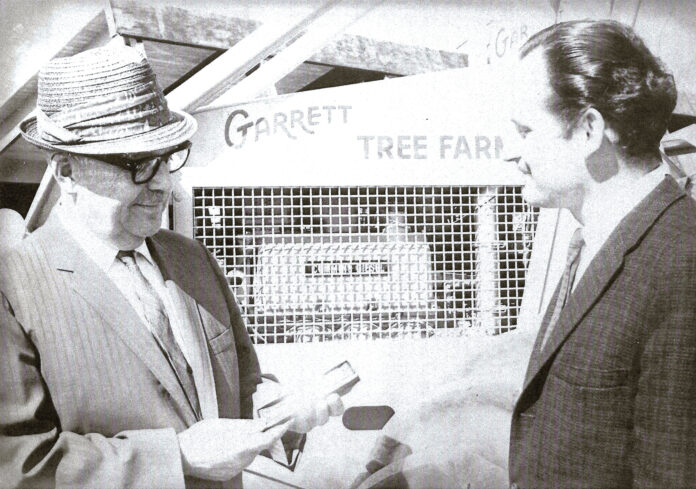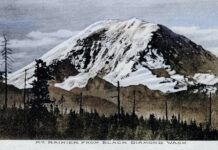Dwight Garrett, left was the consummate inventor, manufacturer, and salesman who transformed the logging industry in the early 1960s. He’s dealing with an unidentified man to the right in this Enumclaw Plateau Historical Society photo #LP1063. During World War II, Garrett operated a fleet of trucks and busses which by 1945 led to the formation of Garrett Motors. That company evolved into a GMC and Buick dealership. Garrett then expanded operations into logging by purchasing cheap, used shovels and cranes in Alaska and transporting them to Enumclaw where they were remanufactured into log loaders. It was in Anchorage where he met an equipment dealer named Cal Bashaw who later moved to Enumclaw and became his business partner. Garrett’s inventive mind led to an idea for a new piece of logging equipment sketched on a napkin during a coffee break in the 1950s. His chief mechanic, Mike Nanovich masterminded the illustration into an articulated skidder for pulling logs out of the woods.
The articulating skidders, or Garrett Tree Farmers as they were known revolutionized logging when smaller, second-growth timber began to dominate the industry. The skidders were originally manufactured in Garrett’s shop building at 2328 Roosevelt Street and later in Gothenburg, Sweden and Toronto, Canada. At its peak, Garrett Enumclaw employed 87 local workers. With their short, arched booms to pull logs and flexible rubber tires to maneuver around stumps, the popular machines were later imitated by national brands such as John Deere and Caterpillar. The first skidder was Garrett Model 10 introduced around 1960. About the same time Garrett built a distinctive sales headquarters featuring a sloped-roof portico supported by large beams set diagonally to the ground. It was located where Garrett Street now intersects Hwy 410. The top of that beam-supported portico is visible in the photo. In that building Garrett’s sales manager, Ron Olson developed relationships with independent loggers known as gypos and displayed paper cut-outs of every skidder sold. Mary Kell was the company bookkeeper.
By the mid-1960s, Garrett’s contacts with logging companies resulted in new business opportunities. At that time a number of State timber sales included the land as part of the bid package. The loggers purchased both land and timber, but had little use for resulting stump farms. They turned to Garrett who offered quick cash to buy the raw land. Cal Bashaw managed this business venture for Garrett as logged-over property was purchased cheaply then resold for higher and better uses. Dwight Garrett was a civic-minded Enumclaw man and school board member in the late ‘60s and early ‘70s. He was also the driving force behind the founding of Cascade Security Bank, as he never got along with the old guard at First National Bank of Enumclaw. But his most notable charitable achievement was Enumclaw Community Hospital. During its early years, Garrett provided half the money necessary to build an emergency wing. Lifetime Enumclaw resident, Jim Puttman recalled, “He was a real scholar and teacher … a real gentleman. You couldn’t help but admire him.” In August 2002, the sloped-beam Garrett building on Hwy 410 was torn down allowing the city to extend Second Street further south. Dwight Garrett passed away on August 4, 2005 at age 89. Second Street was later renamed in his honor and the block where the old Junior High School once stood at 2222 Porter Street was rechristened Dwight Garrett Park.







